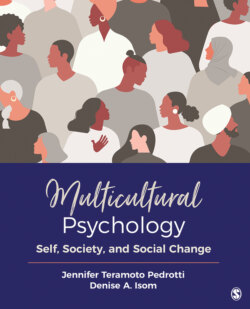Читать книгу Multicultural Psychology - Jennifer T. Pedrotti - Страница 55
На сайте Литреса книга снята с продажи.
Derald Wing Sue’s Worldview Model
ОглавлениеA second very well-known model of worldview was created by psychologist Derald Wing Sue (1978) and is used in many contexts. Sue discusses two main dimensions as a part of his model: locus of control and locus of responsibility. As shown in Figure 3.6, Sue places these two dimensions perpendicular to one another and gives options for more internal or external locus of control and locus of responsibility.
Take a look at the four quadrants in this model. Quadrant I is labeled to be high in both locus of control and responsibility (IC-IR). People who fit into this particular quadrant believe that they have much control over the way in which their life unfolds, and that they thus have a high amount of personal responsibility in terms of successes and failures. This is a very traditional worldview for someone who believes in the American Dream, which explains personal success with personal attributes and hard work, as opposed to luck or privilege. Quadrant II describes people who have a high level of personal responsibility and hold themselves accountable for success and failure, but who also believe that they do not have as much control over their lives and how they are situated within them. (EC-IR). This worldview may lead to some despair in individuals who hold it, as they may feel responsible for their lot in life, and yet recognize that much of it is out of their control. Similarly, those in Quadrant III feel out of control of their lot in life, but they also feel they are not responsible for this fact. This group is a particularly problematic group to be a part of, as individuals who fit into this group may give up trying to improve their lives. In their worldview, the system is against them, and there is nothing they can do about it. Finally, those in Quadrant IV have a high level of internal control, but they also have determined that there are some external forces for which they are not responsible (IC-ER). Individuals who fall into this quadrant are more balanced to some extent in terms of their view of the world, as they see that they lack responsibility for some external circumstances, but they also feel that they have some control over the ways in which they move through their lives.
Description
Figure 3.6 Sue’s Worldview Model
Source: Adapted from Sue, D. W. (1978). Eliminating cultural oppression in counseling: Toward a general theory. Journal of Counseling Psychology, 25, 419–428.
As you have probably already noticed, social identity facets such as race, ethnicity, gender, sexual orientation, socioeconomic status, and other facets may impact the quadrant by which a particular individual can be described. White Americans, for example, have historically had much more control over their own lives than non-White Americans, both in terms of physical freedom (e.g., not enslaved, represented by legislature and judicial systems) and in being less likely to experience discrimination, while racial and ethnic minorities have not always enjoyed this same level of control. Even today, they may be exposed to many more institutional forms of racism and other prejudices based on their belonging to a nonmajority group. That said, if there is a personal sense of control maintained to some extent, there may be more positive psychological antecedents. Consider two African American individuals who would be found in two different quadrants (see table on p. 77).
As you can probably tell, Ben is likely not suffering as many ill effects of the discrimination that appears to be occurring as Michael is, because of Ben’s worldview that this wasn’t really to do with him as a person as much as it was to do with the professors as people. Sue and Sue (2016) have noted that racial and ethnic minorities in this quadrant, who are able to recognize that some forces such as racism or other types of discrimination are external to them as people, often have a higher sense of ethnic identity and pride. An individual like Michael, however, who adopts the dominant cultural norm of an idea like “hard work always equals success,” does not allow himself to consider the fact that his supervisor may be operating based on some biases, however implicit, regarding who “looks like a leader.” Of course, these scenarios are very simplistic—many factors may be at play in both of these situations—but one can still see that a particular type of worldview may impact the psychological health of those in nondominant cultural groups who are experiencing some type of discrimination.
